|
|
|
Sort Order |
|
|
|
Items / Page
|
|
|
|
|
|
|
| Srl | Item |
| 1 |
ID:
131111
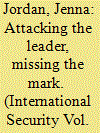

|
|
|
|
|
| Publication |
2014.
|
| Summary/Abstract |
Leadership targeting has become a key feature of counterterrorism policy. Both academics and policymakers have argued that the removal of leaders is an effective strategy in combating terrorism. Leadership decapitation is not always successful, however, and existing empirical work does not account for this variability. A theory of organizational resilience explains why decapitation results in the decline of some terrorist organizations and the survival of others. Organizational resilience is dependent on two variables: bureaucratization and communal support. Older and larger organizations tend to develop bureaucratic features, facilitating a clear succession process and increasing their stability and ability to withstand attacks on their leadership. Communal support plays an important role in providing the resources necessary for terrorist groups to function and survive. Religious and separatist groups typically enjoy a high degree of support from the communities in which they operate, and thus access to critical resources. Application of this theoretical model to the case of al-Qaida reveals that Osama bin Laden's death and the subsequent targeting of other high-level al-Qaida operatives are unlikely to produce significant organizational decline.
|
|
|
|
|
|
|
|
|
|
|
|
|
|
|
|
| 2 |
ID:
178924
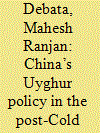

|
|
|
| 3 |
ID:
137168


|
|
|
|
|
| Summary/Abstract |
This article argues that counterterrorism effectiveness is a distinct, discursive construction that politicians use to offer a rationalization of measures adopted under conditions of inherent uncertainty. Even in the face of multiple limits of knowability, decision makers need to offer “rational” justifications complying with persisting expectations of “evidence-based” policy and sound deliberation in modern societies. This article develops a new perspective on the political role of counterterrorism effectiveness highlighting the symbolic importance of knowledge claims and prevailing standards of modern rationality. It illustrates its arguments through a case study on the justification of biometric passports as an effective counterterrorist tool.
|
|
|
|
|
|
|
|
|
|
|
|
|
|
|
|
| 4 |
ID:
137153
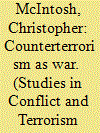

|
|
|
|
|
| Summary/Abstract |
The U.S. war on Al Qaeda is well into its second decade—why has this particular conflict been so difficult to end? This article argues it is not due to the strategic acumen of Al Qaeda, but because of the problems intrinsic to relying on war as the framework for U.S. counterterrorism policy. The normal means of ending wars are complicated with a terrorist enemy and at odds with strategies that have historically had success at the end stages of counterterror campaigns. Continuing along the current path risks an ongoing war the United States will likely neither win nor fully end.
|
|
|
|
|
|
|
|
|
|
|
|
|
|
|
|
| 5 |
ID:
137159


|
|
|
|
|
| Summary/Abstract |
Terrorist organizations’ physical safe havens continue to shape the terrorist threat to the United States by extending the groups’ longevity and increasing the threat they pose. As a result, eliminating terrorist safe havens has been a key component of U.S. counterterrorism policy since at least 2001. However, some scholars challenged the post-9/11 policy consensus that terrorists find sanctuary in weak states and so-called ungoverned spaces. This article seeks to bridge this gap between scholarship and policy by offering a typology for disaggregating different kinds of terrorist safe havens. Our typology operates on two axes based on host government will (i.e., the host government's posture toward each group with haven inside its borders), as well as government capability, (specifically whether the host government possesses the specific capabilities needed to oust each group). This intersection of will and capability produces three types of havens. We briefly illustrate each type of haven using the exemplar case study of Pakistan—a location often described as an overarching safe haven, but which is actually home to several sanctuaries—and offer policy recommendations for addressing them. A need exists to disaggregate and identify how the United States can approach haven elimination. This typology and the analysis that stems from it offer a starting point for devising such strategies.
|
|
|
|
|
|
|
|
|
|
|
|
|
|
|
|
| 6 |
ID:
088750
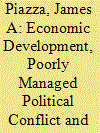

|
|
|
|
|
| Publication |
2009.
|
| Summary/Abstract |
Terrorism is frequently argued to be the product of poverty and poor levels of economic development in countries. Examining the distribution of terrorist attacks and casualties due to terrorism across the states of India, this article demonstrates that the phenomenon of terrorism is not a clear product of poor economic development but rather exacerbated by unresolved and poorly managed political conflict. Poorer states in India are not necessarily more prone to terrorism, but states that have outstanding and poorly addressed political disputes do experience a disproportionately high level of terrorist activity. This study examines six sources of political conflict that contribute to terrorism in India-separatist movements, ethnic conflict, communal conflict, the presence of scheduled castes and tribes, high population growth, and the phenomenon of stateless areas-and makes several observations on the successes and failures of Indian counterterrorism policy
|
|
|
|
|
|
|
|
|
|
|
|
|
|
|
|
| 7 |
ID:
165306
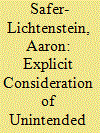

|
|
|
|
|
| Summary/Abstract |
Criminologists and terrorism specialists alike have conducted research on the deterrent effect of policies; however, to date, only criminologists have thoroughly examined the associated displacement of crime and diffusion of benefits. Using data from the Eco-Incidents Database, this study first examines the deterrent effect of government efforts targeting animal rights and environmental terrorism over several years. Next, it extends this application by examining nonterrorist actions by both terrorist groups and nonterrorist groups to see if deterrent actions have any unintended consequences. Results show no evidence of displacement, but rather that several government actions evidenced a diffusion of benefits.
|
|
|
|
|
|
|
|
|
|
|
|
|
|
|
|
| 8 |
ID:
123395
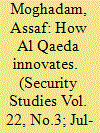

|
|
|
|
|
| Publication |
2013.
|
| Summary/Abstract |
Innovative terrorist organizations pose exceptionally dangerous threats because of their potential to surprise declared enemies, inflict heavy costs upon them, and set new trends that other militant groups seek to emulate. Despite this importance, researchers have shed little light on where terrorist innovation originates. Although military innovation scholars have emphasized the importance of both top-down and bottom-up innovation, the few existing studies on terrorist innovation have acknowledged the importance of the terrorist leadership but largely ignored the role played by middle- or lower-ranking operatives in the innovation process. This study examines the planning of the September 11, 2001 attacks and finds that, contrary to the predominant claims on terrorist innovation, the 9/11 attacks featured both top-down and bottom-up processes of innovation, with the latter including a critical role played by an independent terrorist entrepreneur. Theoretically, the findings suggest that the conventional wisdom of the predominance of top-down innovation in terrorism is dependent on a problematic assumption, namely that terrorist groups are centralized, hierarchical, and localized entities. As more terrorist groups adopt decentralized structures, they are increasingly likely to display multi-directional processes of innovation. The study has important implications for counterterrorism policy. It suggests that thwarting the most innovative terrorist groups requires targeting senior- and middle-management operatives of the group itself and expending greater effort at apprehending independent terrorist innovators with fluid organizational affiliations. A mix of offensive and defensive counterterrorism strategies, coupled with greater international cooperation, is critical to achieving this goal.
|
|
|
|
|
|
|
|
|
|
|
|
|
|
|
|
| 9 |
ID:
144874
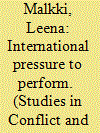

|
|
|
|
|
| Summary/Abstract |
The major terrorist attacks in Western countries during the last fifteen years have had consequences way beyond the countries in which they have happened. The article provides a primary source–based account of the development of counterterrorism policy in Finland, which is one of those countries with a low national threat level. The article demonstrates the significant role that international pressure, through obligations, recommendations, and social learning, plays in developing national counterterrorist policies. The article calls also into question whether the pressure to comply with international pressure always contributes toward sound national counterterrorism policies that foster political resilience to terrorism.
|
|
|
|
|
|
|
|
|
|
|
|
|
|
|
|
| 10 |
ID:
098177
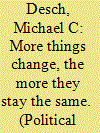

|
|
|
| 11 |
ID:
140530
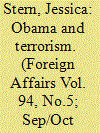

|
|
|
|
|
| Summary/Abstract |
U.S. President Barack Obama came into office determined to end a seemingly endless war on terrorism. Obama pledged to make his counterterrorism policies more nimble, more transparent, and more ethical than the ones pursued by the George W. Bush administration. Obama wanted to get away from the overreliance on force that characterized the Bush era, which led to the disastrous U.S. invasion of Iraq in 2003. That war, in turn, compromised the U.S. campaign against al Qaeda. During the past six-plus years, Obama has overseen an approach that relies on a combination of targeted killing, security assistance to military and intelligence forces in partner and allied countries, and intensive electronic surveillance. He has also initiated, although in a tentative way, a crucial effort to identify and address the underlying causes of terrorism. Overall, these steps amount to an improvement over the Bush years.
|
|
|
|
|
|
|
|
|
|
|
|
|
|
|
|
| 12 |
ID:
144933
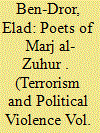

|
|
|
|
|
| Summary/Abstract |
In December 1992, after the kidnapping and murder of a policeman, Israel deported 415 members of Hamas and Islamic Jihad to Lebanon. Most were affiliated with the Hamas political apparatus and had not been involved in terrorism. The deportees decided to stay together and set up a camp in Marj al-Zuhur in southern Lebanon. Here they engaged in study and various cultural pursuits—including poetry writing. Roughly a dozen of the deportees wrote poetry. The poems were read aloud at gatherings in the camp and published in the Arab press. Their main function was to raise the residents’ spirits and keep their plight in the public eye. They incorporate the expected political messages: anger at Israel and criticism of the international community, the Palestinian leadership, and the Arab states, which were prodded to work harder for the deportees’ return. The poetry was part of a successful media and information campaign, which annoyed Israel so much that it allowed all the deportees to return home by December 1993. Some of the poems were later published and helped cultivate the myth of the Marj al-Zuhur deportation, which Hamas viewed as a victory and symbol of steadfast resistance to Israel.
|
|
|
|
|
|
|
|
|
|
|
|
|
|
|
|
| 13 |
ID:
144927
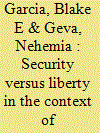

|
|
|
|
|
| Summary/Abstract |
A critical question in counterterrorism studies concerns the extent to which governments adequately balance the continual provision of individual rights and freedoms with the appropriate level of national security when faced with a terrorist attack. We experimentally assess this tradeoff utilizing a 2 × 2 × 2 between-groups factorial design, manipulating (a) the extent of terror-related threats, (b) the level of invasiveness of subsequent counterterrorism policies, as well as (c) the terror context: transnational and domestic. The results provide evidence that the public is more willing to accept greater reductions in civil liberties under a greater threat of terrorism only when the perceived effectiveness of those policies to prevent future acts of terrorism is high. Furthermore, we find these results to be specific to the context of a transnational terror threat. This suggests that the public will be unwilling to accept reductions in civil liberties when the source of the attack is domestic, regardless of the level of threat or how effective subsequent policies may be in preventing future attacks.
|
|
|
|
|
|
|
|
|
|
|
|
|
|
|
|
| 14 |
ID:
150978
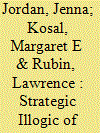

|
|
|
|
|
| Summary/Abstract |
In the last few years, the Islamic State, or IS, has become a central focus of public debates about U.S. national security. A May 2016 poll by the Pew Research Center reported that 80 percent of Americans think IS poses the greatest international threat to the United States.11. “Public Uncertain, Divided Over America's Place in the World,” Pew Research Center, May 5, 2016.
|
|
|
|
|
|
|
|
|
|
|
|
|
|
|
|
| 15 |
ID:
191005
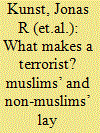

|
|
|
|
|
| Summary/Abstract |
The question of why people become terrorists has preoccupied scholars and policy makers for decades. Yet, very little is known about how lay people perceive individuals at risk of becoming terrorists. In two studies conducted in the U.K., we aimed to fill this gap. Study 1 showed that Muslims and non-Muslims perceived a potential minority-group terrorist in terms of both structural (e.g., life-history, social) and individual risk factors (e.g., personality, psychopathology, ideology). In Study 2, Muslims and non-Muslims perceived a potential right-wing majority-group terrorist as having more individual predispositions to terrorism than a potential left-wing majority-group terrorist. Importantly, in both studies, individualist perceptions such as psychopathology were positively associated with support for stricter law enforcement, whereas structuralist perceptions such as adverse childhood experiences were positively associated with support for social interventions. Lay people seem to have multifactorial understandings of individuals at risk of becoming terrorists, which influence their counterterrorism policy support.
|
|
|
|
|
|
|
|
|
|
|
|
|
|
|
|
|
|
|
|
|